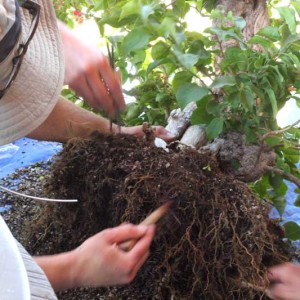
Trimming roots is a maintenance necessity that can sometimes cause anxiety. However, trimming the roots of your tree when repotting will help your tree grow healthier and stronger.
So what exactly do you cut and dont cut: Your trees roots primarily consist of a tap root, the primary root, and several hair and feeder roots. The first thing you will need to do is expose the roots by removing the soil. We recommend using a repotting stick to clean away old soil that is compacted and clumping the roots of your tree. Use the stick to gently dig and pull away hardened soil away from the roots to loosen them.
Cutting the Tap Root: This will depend on the species of the tree. At our nursery, we dont hesitate to cut back the tap roots on junipers and black pines. Other species may be more sensitive. You will need to double check prior to cutting the tap root. Most likely, the tap root will not need to be cut if the tree has been in a pot for some time. If you decide to cut the tap root, use a nice sharp root cutter to make your job easier and make a cleaner cut.
Remove Rotted Roots and Excess Feeder Roots: After you have exposed the roots, cut the rotting roots. Rotted roots are dark brown in color and almost fall apart when they are touched. Cut these back. Then cut the feeder roots back. This will help to promote new healthier feeder roots to develop. Most often your maintenance will involved cutting back feeder roots only.
Dont forget to use a good soil mix when you repot. Doing so will promote better root growth and cut down the frequency of repotting your tree. It will also make it easier to repot the next time around.
So what exactly do you cut and dont cut: Your trees roots primarily consist of a tap root, the primary root, and several hair and feeder roots. The first thing you will need to do is expose the roots by removing the soil. We recommend using a repotting stick to clean away old soil that is compacted and clumping the roots of your tree. Use the stick to gently dig and pull away hardened soil away from the roots to loosen them.
Cutting the Tap Root: This will depend on the species of the tree. At our nursery, we dont hesitate to cut back the tap roots on junipers and black pines. Other species may be more sensitive. You will need to double check prior to cutting the tap root. Most likely, the tap root will not need to be cut if the tree has been in a pot for some time. If you decide to cut the tap root, use a nice sharp root cutter to make your job easier and make a cleaner cut.
Remove Rotted Roots and Excess Feeder Roots: After you have exposed the roots, cut the rotting roots. Rotted roots are dark brown in color and almost fall apart when they are touched. Cut these back. Then cut the feeder roots back. This will help to promote new healthier feeder roots to develop. Most often your maintenance will involved cutting back feeder roots only.
Dont forget to use a good soil mix when you repot. Doing so will promote better root growth and cut down the frequency of repotting your tree. It will also make it easier to repot the next time around.
